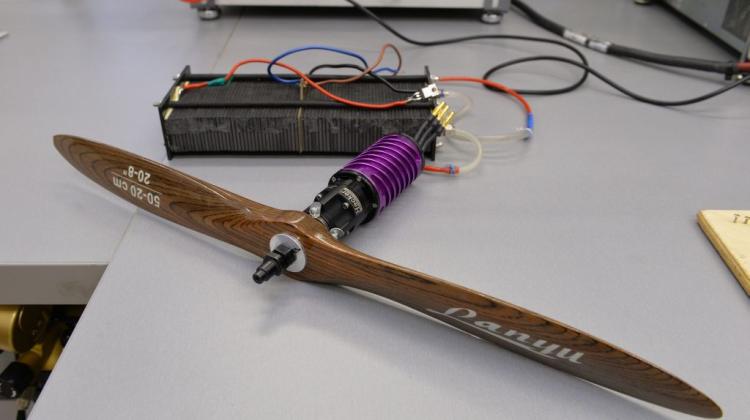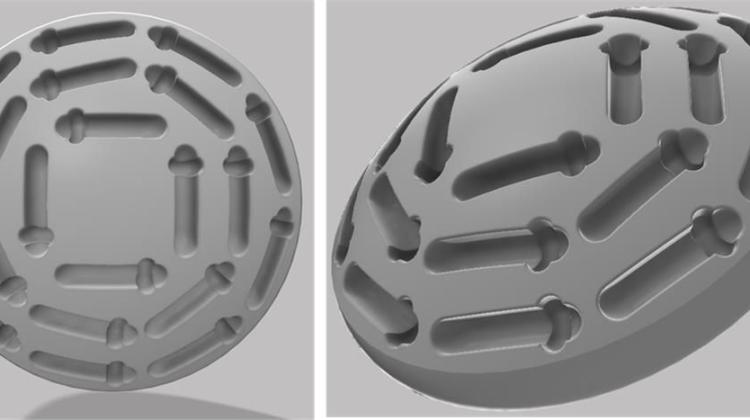Undetectable hydrogen-powered drones
 Presentation of hydrogen cells, built to power silent drone invisible to infrared detectors. Photo: Fot. PAP/ Jacek Bednarczyk 07.03.2014
Presentation of hydrogen cells, built to power silent drone invisible to infrared detectors. Photo: Fot. PAP/ Jacek Bednarczyk 07.03.2014
Prototype silent and invisible to infrared detectors hydrogen-powered drone was built by effort of researchers from the AGH University of Science and Technology, and Rzeszów University of Technology. The aircraft could be used for example by the army and police.
Unmanned flying device developed within the framework of Polish R&D project "Low power drives to power unmanned aerial vehicles" has the power demand of about 300 W. Prototype had already been built and flight tested.
Project member Dr. Piotr Tomczyk from the Faculty of Energy and Fuels at AGH said in an interview with PAP that AGH was responsible for the design of the drone drive, Faculty of Mechanical Engineering and Aeronautics of Rzeszów University of Technology for the drone design, and Aviation Production and Repair Company "Aero-Kros" in Krosno built the aircraft. Project was coordinated by the Institute of Power Engineering Ceramic Department CEREL in Boguchwała.
Although drones which use fuel cells, have been developed before in various places around the world, Polish researchers decided to develop their own manufacturing technologies for unmanned aircrafts.
For now, drones are driven mostly by internal combustion engines. According to Piotr Tomczyk, these engines are lightweight, have high power and reach, but they also have their drawbacks. The problem is, for example, that they are loud, and the engine noise makes it easier to detect drones. In addition, internal combustion engines used to drive the drone emit a lot of heat, so the machine can be traced with infrared detectors, used, for example, in homing rockets. Another problem is that internal combustion engines emit exhaust gases.
A possible solution is to replace the drone’s internal combustion engine with electric motor powered by a battery. However, batteries are relatively heavy. Therefore, designers focused on fuel cells. Piotr Tomczyk explains that fuel cells - like the internal combustion engine - also need fuel. It is usually hydrogen. The researcher says that the cost of the use of hydrogen is comparable to the price of gasoline. A fuel cell would also be approximately five times lighter than a battery that would achieve a similar flight range.
With this drive, the drone is much quieter (although you can still hear the propeller) and does not give off as much heat as the internal combustion engine. According to Piotr Tomczyk, the fuel cell operates in the temperature range of 60-80 degrees Celsius, and if the drive is shielded, it will be almost imperceptible to the infrared cameras. "This is a huge advantage of our drone. At night, such aircraft can not be seen, and can hardly be heard, which makes it almost impossible to detect" - noted Dr. Tomczyk. He added that the aircraft would not emit exhaust gases harmful to the environment, or even excess heat - the exhaust gas is water vapour only.
Dr. Tomczyk explained that 1L bottle of hydrogen allows for about a half hour flight of the drone. To increase the range of the machine, instead of compressed hydrogen fuel cell can use chemical hydrogen source - hydrogen is produced during the flight, in a chemical reaction. With this solution, drone with a container with a similar volume and weight could fly much longer without interruption - even for two hours.
"The market is currently very open to drones" - commented the researcher from AGH. He admitted that such devices can be used not only by the military, but also the police - for example in crowd control and road traffic. Unmanned aircrafts could also be used to check the safety of energy networks and forests.
The project was carried out in 2010-2013 with funds from the National Research and Development Centre. Dr. Tomczyk admitted that Polish hydrogen drones would not go into mass production just yet - although the prototype confirmed the advantages of this drive, further work on their improvement and drone systems is necessary. The researchers are involved in future projects. "We see interest in our research, especially from the Aviation Valley in Mielec" - concluded the expert from AGH.
PAP - Science and Scholarship in Poland, Ludwika Tomala
lt/ ula/
tr. RL
Przed dodaniem komentarza prosimy o zapoznanie z Regulaminem forum serwisu Nauka w Polsce.


















